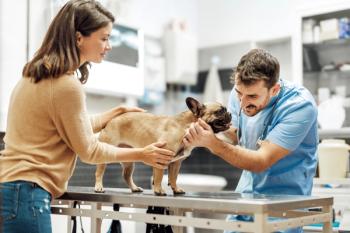
Exploratory surgery is like a box of chocolates
Sometimes it's gooey and unpredictable, and often it can get a little bit nuts.
Admit it, do you ever take a bite of the raspberry cream chocolate and then put it back? (Photo courtesy of Getty Images)Clients would prefer to know the outcome of their pet's illness from the start, no twist endings-or stomachs-in this story, please. But at best we're in the middle of a choose-your-own-adventure story, and the client is just hoping we make the right choice.
It's 5 p.m., and a 2-year-old mixed-breed dog is brought in after vomiting for the past two days. The serum chemistry and CBC show a decrease in chloride and a mild leukocytosis. The radiographs show a questionable radiodense opacity on two of the three views that sure could be a bunched-up sock. This situation leads to one of the ultimate questions for a veterinarian: to cut or not to cut.
This situation leads to one of the ultimate questions for a veterinarian: to cut or not to cut.
Please don't be the orange cream …
Diagnostic tools such as a barium series or ultrasound can further help this situation if they're accessible. But even with these extra diagnostics the answer isn't always clear.
Certainly time of day and schedule play a role in the clinician's aggressiveness. An even more important factor is the doctor's philosophy. Some don't want to go into abdomen
unless they're sure there will be something to take out. Others view an exploratory surgery as another diagnostic tool. If a foreign object isn't found, take biopsies, do a therapeutic flush and suction, and cross another item off the rule-out list.
There's no single, clear-cut answer in these situations. But because the outcome is fraught with uncertainty, the most important aspect is to include the owner in the conversation and decision-making process. They're the ones paying the bill for an expensive surgery, and they need to be aware of the risks. If the owners are aware of the possibility of a negative exploratory, they'll be more accepting of the cost-and the outcome.
When you tell the client it's caramel and it's really nougat
Another interesting situation: When you perform an exploratory surgery and what you find isn't at all what you expected or discussed with the owner beforehand.
I recently saw an intact 2-year-old female for inappetence and foul-smelling odor. Her abdomen was distended, and on ultrasound most of the abdomen was filled with an encapsulated fluid-filled organ. My conclusion was pyometra, and we went to surgery. On entering the peritoneum, I quickly discovered that what I thought was the uterus was actually the most distended bladder I'd ever seen. There was also serosanguineous free fluid in the peritoneum and brown material caked along the intestines, interwoven in the omentum and serosa of the bladder.
There was also serosanguineous free fluid in the peritoneum and brown material caked along the intestines, interwoven in the omentum and serosa of the bladder.
A small, now-healing perforation was found in the distending colon. This dog had been hit by a car and broken her pelvis and somehow walked away from it. She was suffering from peritonitis as well as a distended bladder due to nerve damage. Flush and lavage and decompressing the bladder still made the exploratory surgery necessary, but I had a different story to tell the owner after surgery.
Perhaps an exploratory surgery should be thought of as both a diagnostic tool and a treatment. The decision is the right one if you communicate clearly with the owner, regardless of the outcome. More often than not, things aren't as they appear. And if you start by presenting the unexpected possibilities to the pet owner, it'll be a lot easier to deliver the actual result, no matter what crazy twist occurred at the end of the story.
Dr. Andrew Rollo is a regular dvm360 contributor and an associate at Madison Veterinary Hospital in Madison Heights, Michigan.
Newsletter
From exam room tips to practice management insights, get trusted veterinary news delivered straight to your inbox—subscribe to dvm360.






